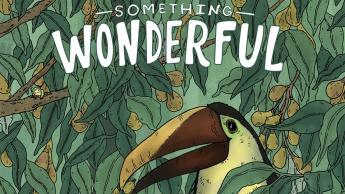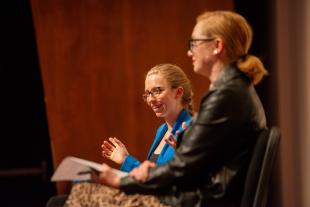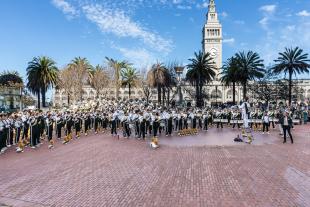Biology Professor and Forestry Grad Team Up to Publish “Something Wonderful” for Kids

How do you get kids interested in science and ecology? According to Matt Ritter and Nayl Gonzalez, the answer lies somewhere between facts and fun.
This spring Ritter, a professor of biology, and Gonzalez, a 2020 forestry grad, published “Something Wonderful,” a new children’s book that dives into the complex life cycle of a tropical fig tree and the rainforest creatures that help it along the way.

Ritter recruited Gonzalez to illustrate the book during her senior year at Cal Poly. The collaborative process involved more than a year of iterative work to get the details right — and the book is all about the details, from the renderings of the plants to the playful animals hidden in the intricate forest backgrounds.
“I've always had this idea of trying to interest young people in ecology and the complicated web of interactions between organisms,” said Ritter, who has written several books on plants and ecology aimed at casual readers. “Something Wonderful is targeted at kids between 4 and 10, and I knew it would be important to get them looking closely at the pages.”
“The biggest challenge was trying to make it look scientifically accurate, but also easy and fun enough for a child to look at and enjoy,” said Gonzalez.
As a forestry major, illustration was a useful skill for Gonzalez. She worked at Cal Poly’s Disability Resource Center, where her notes and sketches of wildlife have been invaluable as visual learning aids to students with special needs. In 2019 she created the official scientific drawing of a new species of flower that Cal Poly students and faculty discovered in the Irish Hills area of San Luis Obispo.

She grew up drawing and sketching, and recalls camping trips as a child where she would draw all the plants and trees around her — but she had never thought of it as a possible career path. “Scientific illustration was a whole new trajectory for me,” she said, “It wasn’t until I took my first botany classes at Cal Poly that I even considered that this is a job that people do.”
Gonzalez is continuing to hone her skills and hopes to continue working with researchers and scientific journals. She recently enrolled in a science illustration course at CSU Monterey Bay and is collaborating with Ritter again on an upcoming project, an illustrated children’s guide to California wildlife.
Her dream is to one day launch a nonprofit aimed at making science and ecology more accessible to underserved kids growing up in cities. She recalls her own childhood in Pomona and the feeling that nature wasn’t a part of everyday life.
“Learning about the plants around you wasn't a typical thing to study,” she said. “I'd love to help expand that into more diverse communities.”
It’s a goal that Ritter shares — and that shapes his approach to storytelling.
“I think that these types of books are more important than technical non-fiction books, in the sense that you have the potential to interest a lot of people in ecology and conservation,” says Ritter. “People are not going to all become biologists — they're going to become lawyers and doctors and plumbers and everything else — but you want those people, in the background of their minds, to be thinking about how nature is important and worth learning about and protecting.”




